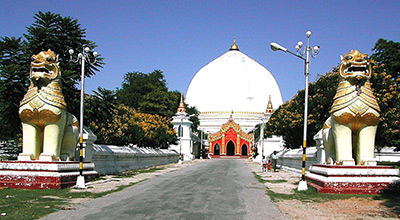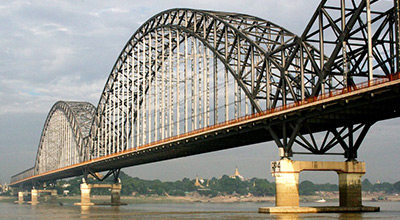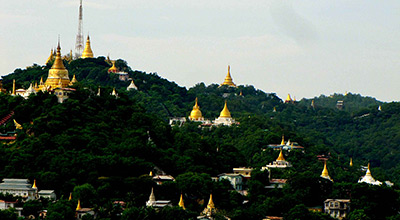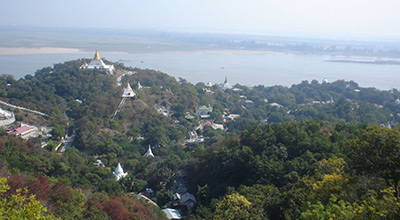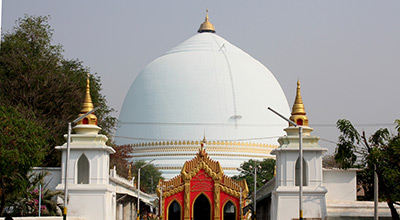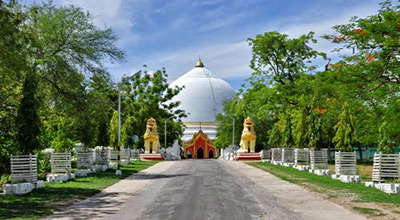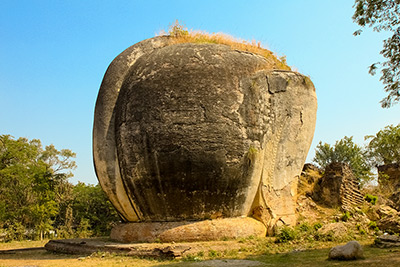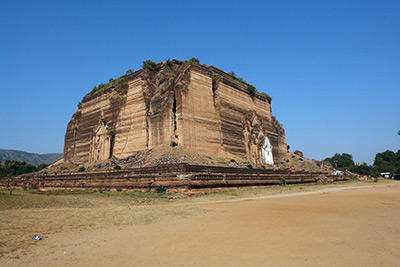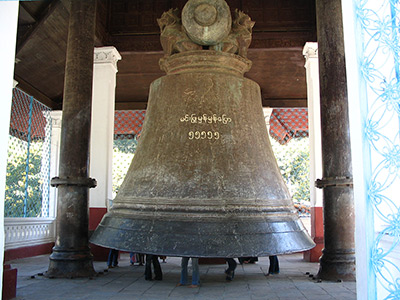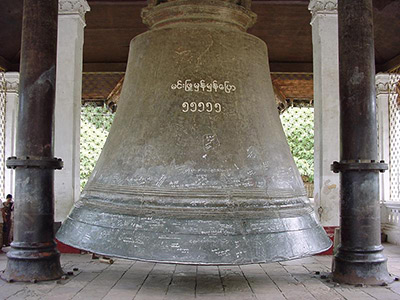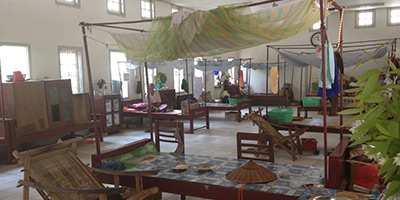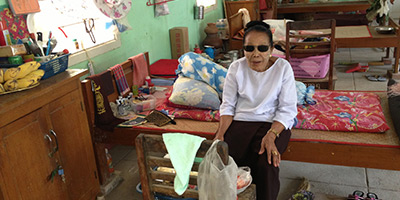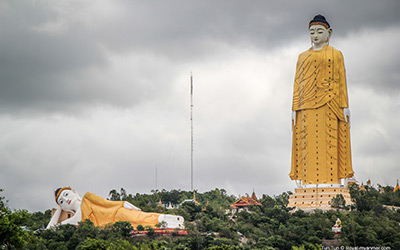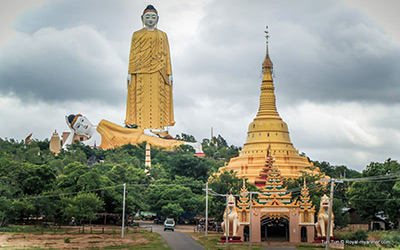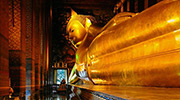Sagaing
Sagaing lays 21km south-west of Mandalay on the west bank of the Ayeyarwaddy River. It lies in Sagaing division which is the largest division in Myanmar. Sagaing became the capital of an independent Shan kingdom around 1315 after the fall of Bagan. Its period of importance was short for in 1364 the founder's grandson. Thado Minbya moved his capital across the river to Inwa. From 1760 to 1764 Sagaing was once again the capital. Today Sagaing is known as a meditation centre. Myanmars all over the country would visit Sagaing for the purpose of religious retreat.Among the four main rivers of Myanmar, Ayeyarwaddy, Sittaung, Chin Dwin and Thanlwin. The Chin Dwin River flows through this division. Inwa Bridge connects Mandalay and Sagaing crossing the mighty ayeyarwaddy
Sagaing Hill
Once you cross the Inwa Bridge. You see the hilltops. Each crested with a pagoda. The banners are proclaiming the Buddha's teaching. The refuge from all ills and tribulations are where over 600 monasteries for monks and nuns are located for Buddhist studies and meditation. The Padamyazedi dates from 1300 while the U min Thonze or thirty caves pagoda has many Buddha images in a crescent shaped colonnade. Mural paintings can be seen in the Tilawkaguru cave temple which was built around 1672. At the nearby village of Ywahtaung you can see silver workers producing bowls and other silver items by traditional methods. The most impressive Soon Oo Pon Nya Shin Pagoda nearby was constructed in 1312. The view of Sagaing from Soon Oo Pon Nya Shin and its approach is marvelous.
Kaung Hmu Daw Pagoda
The Kaung-hmu-daw Ceti (Pagoda) , also called Raja Munisula, is a large white pagoda six miles north of Sagaing, built by King Thalun (Thadoe Dhamma Yarzar) and his son, Ngadakadayaka in A.D 1636. It was raised to celebrate the resettlement of the Capital of Innwa (Ava) and is in the ancient hemispherical form, after the design of the Mahaceti pagoda in Sri Lanka. A gold image of the Buddha, in the equivalent weight of the king was cast and enshrined in the lower relic chamber. This hemispherical form of white pagoda, over 150 feet high and 900 feet in circumference at the base, took 12 years to build. The legend has it that it was inspired by the perfect breasts of the favorite wife of King Thalun. It is said the Lord Buddha's "Tooth of Kandy" have been enshrined inside the pagoda.
Mingun
Mingun is located across majestic Ayeyarwaddy River approximately 12 kilometer north of Mandalay. Mingun today host the world second largest ringing. Bell of 90 tons is in weight and unfinished pagoda to go with it. Mingun payagyi was dedicated to be the world largest monument however which today stood to be the world largest brick pile. It is reached by ferry boats across the river and takes 1 hour for up-river. A boat trip to Mingun is pleasant with plenty of life on the river to see.
Mingun Pagoda
Mingun is located on the western bank of the river Ayeyarwaddy. approximately 7 miles north of Mandalay. It is reached by ferryboats across the river and takes 1 hour for up-river and 40 minutes for down-river. It is famous for many Buddhist shrines. monasteries. meditation centres and monuments of historical and cultural importance. A boat trip to Mingun is pleasant with plenty of life on the river to see. It is about 11 miles from Sagaing and you can reach there by road. It takes about 30 minutes. And you can also travel to Mingun from Mandalay but you can get there by road. It is about 7 miles up river from Mandalay and you can accessible only by boat. Via Gawwein jetty.The journey takes 45 minutes when you come along the motor way to Mingun from Sagaing. You will first arrive at Kandawgyi one of the prominent big four in Mingun. Kandawgyi was formed while digging earth to make bricks for building of Mingun Pahtodawgyi. It was built by King Bodaw Badon in 1791. You will arrive at Mingun Pahtodawgyi from Kandawgyi .Now. We are here at the Mingun Pahtodawgyi from the top of the Pagoda you can view the scene of Mingun and Ayeyawady river. You can use this stair to climb to the top and there are all together 174 steps.It is reached by ferryboats across the river and takes 1 hour for up-river and 40 minutes for down-river. The journey takes 45 minutes when you come along the motor way to Mingun from Sagaing. You will first arrive at Kandawgyi one of the prominent big four in Mingun. It is one of the famous buildings in the world. The building of Mingun Pahtodawgyi started in 1791. Hand it been completed it would have a height of some 500 feet. It was stopped at 162 feet height. Its girth is about 450 square feet. This is Pondawya Pagoda which is prototype of Mingun Pahtodawgyi. You can study Myanmar arts and crafts of Kongbaung period in Mingun Pahtodawgyi. King Bodawpaya built Mingun Pahtodawgyi aiming to worship from Shwebo in the distance where he has ascended the throne. The pagoda was left unfinished. Two enormous prominent statues of lions in Mingun one of the tourist atttractions is at the east stairway of Pahtodawgyi which faces the Ayeyawaddy river.From here. you can also enjoy natural scenic beauty of Ayeyawady river and green and pleasant Minwun hill. If this pagoda been completed. Then it would have been the largest monument. This unfinished structure was badly damaged with cracks by the earthquake of 1838 but it is still the largest brick base in the world.
Myatheintan Pagoda
Mya Thein Tan was built in Mingun of Sagaing Division by King Sagaing. enshrining an emerald worth about 100.000 on die 15th waxing moon day of Tagu. 1163 ME. It was also called Shinbyu Phaya as it was a repository of Shinbyu Phaya donated by King Alaung Sithu. It is also known as Sinbyumai it was built by Setkya Mingale in fond memory of his late mother. Sinbyumai. The wall was meant to signify the solar system.The seven terraces like the waves was to signify the seven rivers and seven mountains the seventh terrace was to signify the peak of Ugando Mountain and at the centre was a brick structure encircled by a five-tier structure and it conveyed the sign of the Mount Meru. The pagoda was an image of Sulamani Pagoda at the peak of Mount Meru in Tavatimsa plane of nats. The surrounding pyathats signify the abode of the nats. The three tazaungs signified the three from the nat world to Thingathanago prepared for Buddha to descend from Tavatimsa. Each has 53 steps.
Mingun Bell
King Bodawpaya also had a big bronze bell near the Mingun Pahtodawgyi in 1808. King Bodawpaya dedicated to construct a gigantic Pagoda, a gigantic bell and a gigantic lion during his reign. But he was not able to complete the pagoda. The Mingun Bell is one of the world's largest ringing bells dated A.D 2000. It is located on the west bank of Ayeyarwaddy River, Mingun Town, Sagaing Region. The weight of the bell is 55,555 viss (90 tons) and about 13 feet tall. This number is conveniently remembered by many people in Myanmar as "Min Hpyu Hman Hman Pyaw", with the consonants representing the number 5 in Burmese astronomy and numerology. The Mingun Bell was knocked off its supports by the earthquake of 1839. It was resuspended by the Irrawaddy Flotilla Company in 1896.
Mingun Aged Home
The Mingun Home was founded by Daw Oo Zun herself in senior year in 1915 with a view to looking after old destitute and in need of care and comfort. It is the first home for the ages establish in Myanmar. Another place you can study is the monastery where Sayadaw U Viseitta Sara Vivamsa winner of Tipitaka Title resided. The late sayadaw was listed in the Guinness Book of records as one of the most intelligent men in the world.
Monywa
Monywa is situated about 136km to the west of Mandalay.It’s also the commercial center.A picturesque town on the Chinewin River, Monywa is known as a typical unspoilt Myanmar town and it is only a three hours’ drive from Mandalay. On the way to Monywa and before you reach the town there is unusual Buddhist temple complex on 37 acres of land called Mohnyin Thanbiddhay. Monywa also famous for Pho Win Taung (Mt. Pho Win), Mt. Shwe Ba where the entire mountain was carved into caves, niches, staircases and Buddha Images.
Bawditahtaung Pagoda
Maha Bodhi Ta Htaungis a famous Buddhist region and monastery located in Monywa Township, Sagaing Region, Myanmar (Burma). It is famous for the Giant Standing Buddha statue, the second largest in the world, and for the Gratitudes of U Narãda, who built the monastery. The site contains thousands of Buddha images and Bo trees, the Giant Reclining Buddha Image, Aung Sakkyã Pagoda, and other large Buddha Images in the Sãsanǎ region. Many Buddhist monks can study the Buddhist Pariyatti literature at the monastery. Moreover, meditation centres or Vipassãnã centres are opened at the monastic region both for monks and laypersons.
History
Maha Bodhi Ta Htaung was founded by Maha Bodhi Ta Htaung Sayadaw Ven Nãrada on the 5th May, 1960. He planted thousands of Bo trees throughout his life. He started to plant them on a 15 acres (6.1 ha) plot, with Nan Oo Sayadaw, the grandson of King Mindon, at 8.55 AM on the 6th May 1960. Bo trees hold religious significance for Buddhists since it is the tree under which Buddha attained enlightenment. Before he reached this monastery, the monastery is just one for Khatakkan villagers. Now, the 15 acres (0.061 km2) Bodhi Ta Htaung (One Thousand Bo Trees) Auspicious Ground has been extended to a 250 acres (1.0 km2), it is lush and green with more than 9,000 Bo trees. The monastery is famous in both Myanmar and the world since it has got many thousands of Bodhi trees.
Lay Kyun Satkyar Standing Buddha
Built in 1995, the Laykyun Setkyar Buddha statue is 424 feet (129 m) high with thirty one floors (referring to the 31 planes of existence). It is the second largest Buddha statue in the world. Construction of the statue was finished in 2008.[1][2] On Banda vah mountain in Bodhi Tahtaung monastery, the Sitting Buddha statue is planned to build soon.
Big Reclining Buddh
Next door to the Grand Palace you’ll find the Temple of the Reclining Buddha (Wat Pho). It’s the largest and oldest wat (temple) in Bangkok and, as the name suggests, is home to the enormous reclining Buddha. You’ll also find many more Buddha images at Wat Pho, which is said to have more statues of the Buddha than any other Bangkok temple.The Reclining Buddha was crafted to celebrate King Rama III’s restoration (1824 - 51). At 150 ft (46 m) long and 49 ft (15 m) high it is the largest Buddha image in Thailand. The reclining Buddha is decorated with gold leaf and his eyes and foot soles are inlaid with mother-of-pearl.
Shweguni Pagoda
Shwe Gu Ni Buddha Image lies in Kyaukka village ten miles east of Monywa Township in Sagaing Division. It was one of the 34.000 pagodas built by King Thin Dharnma Thawka. At that time Kyaukka was known as Kyaukthan and it was known as Myo-Oo Athawka pagoda at the head of the city.A new pagoda was built on top of it by the King of Kyaukka under the reign of King Mingaung Gyi of Innwa in 762. It was then known as Kyaukka Shwegu Pagoda. In 1000 under King Thalun. the pagoda was damaged and the original pagoda was retraced and built anew by Ashin Nyana Myinzu. the Sayadaw of Kyaukka.It was then known as Kyaukka Shweguni. In 1189. under King Bagyidaw Phannanshin. the Sayadaw of Kyaukka rebuilt it to be 34 cubits at its base and 72 cubits in its height up to the diamond bud. In the cave is a reclining pagoda four cubits high. It has been so gilded by devotees that it is like a gold piece almost devoid of human features.


